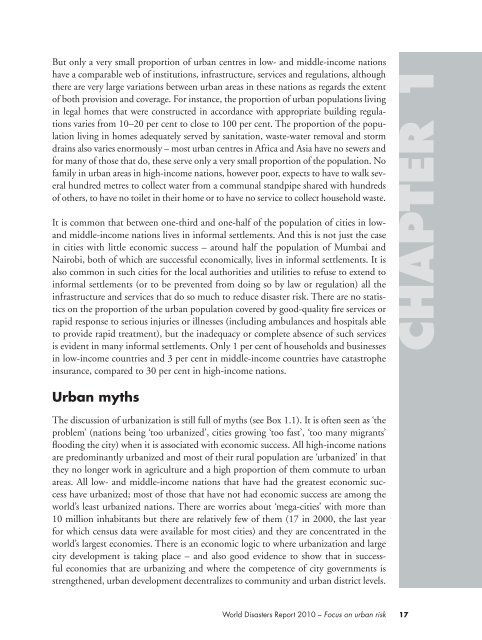World Disasters Report 2010 - International Federation of Red Cross ...
World Disasters Report 2010 - International Federation of Red Cross ...
World Disasters Report 2010 - International Federation of Red Cross ...
You also want an ePaper? Increase the reach of your titles
YUMPU automatically turns print PDFs into web optimized ePapers that Google loves.
But only a very small proportion <strong>of</strong> urban centres in low- and middle-income nations<br />
have a comparable web <strong>of</strong> institutions, infrastructure, services and regulations, although<br />
there are very large variations between urban areas in these nations as regards the extent<br />
<strong>of</strong> both provision and coverage. For instance, the proportion <strong>of</strong> urban populations living<br />
in legal homes that were constructed in accordance with appropriate building regulations<br />
varies from 10–20 per cent to close to 100 per cent. The proportion <strong>of</strong> the population<br />
living in homes adequately served by sanitation, waste-water removal and storm<br />
drains also varies enormously – most urban centres in Africa and Asia have no sewers and<br />
for many <strong>of</strong> those that do, these serve only a very small proportion <strong>of</strong> the population. No<br />
family in urban areas in high-income nations, however poor, expects to have to walk several<br />
hundred metres to collect water from a communal standpipe shared with hundreds<br />
<strong>of</strong> others, to have no toilet in their home or to have no service to collect household waste.<br />
It is common that between one-third and one-half <strong>of</strong> the population <strong>of</strong> cities in low-<br />
and middle-income nations lives in informal settlements. And this is not just the case<br />
in cities with little economic success – around half the population <strong>of</strong> Mumbai and<br />
Nairobi, both <strong>of</strong> which are successful economically, lives in informal settlements. It is<br />
also common in such cities for the local authorities and utilities to refuse to extend to<br />
informal settlements (or to be prevented from doing so by law or regulation) all the<br />
infrastructure and services that do so much to reduce disaster risk. There are no statistics<br />
on the proportion <strong>of</strong> the urban population covered by good-quality fire services or<br />
rapid response to serious injuries or illnesses (including ambulances and hospitals able<br />
to provide rapid treatment), but the inadequacy or complete absence <strong>of</strong> such services<br />
is evident in many informal settlements. Only 1 per cent <strong>of</strong> households and businesses<br />
in low-income countries and 3 per cent in middle-income countries have catastrophe<br />
insurance, compared to 30 per cent in high-income nations.<br />
Urban myths<br />
The discussion <strong>of</strong> urbanization is still full <strong>of</strong> myths (see Box 1.1). It is <strong>of</strong>ten seen as ‘the<br />
problem’ (nations being ‘too urbanized’, cities growing ‘too fast’, ‘too many migrants’<br />
flooding the city) when it is associated with economic success. All high-income nations<br />
are predominantly urbanized and most <strong>of</strong> their rural population are ‘urbanized’ in that<br />
they no longer work in agriculture and a high proportion <strong>of</strong> them commute to urban<br />
areas. All low- and middle-income nations that have had the greatest economic success<br />
have urbanized; most <strong>of</strong> those that have not had economic success are among the<br />
world’s least urbanized nations. There are worries about ‘mega-cities’ with more than<br />
10 million inhabitants but there are relatively few <strong>of</strong> them (17 in 2000, the last year<br />
for which census data were available for most cities) and they are concentrated in the<br />
world’s largest economies. There is an economic logic to where urbanization and large<br />
city development is taking place – and also good evidence to show that in successful<br />
economies that are urbanizing and where the competence <strong>of</strong> city governments is<br />
strengthened, urban development decentralizes to community and urban district levels.<br />
<strong>World</strong> <strong>Disasters</strong> <strong>Report</strong> <strong>2010</strong> – Focus on urban risk<br />
17

















